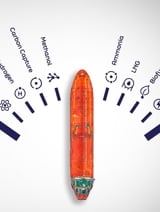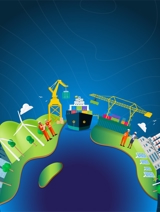As the world has now entered a period of unprecedented trade turmoil, there are broad implications for international shipping as a whole. But perhaps the outlook is particularly uncertain for container lines running on long haul global trades. Here, LR’s Global Container Segment Director, Nick Gross, addresses some of the key factors including the risk of overcapacity on some routes.
Which sectors of the container ship fleet are most at risk of overcapacity and why?
A statistical analysis of the existing container ship fleet and orderbook is a reasonable starting point for assessing the risk of overcapacity. But, as we shall see, it is only part of the story.
Using end-September figures from the IHS-Markit database, we can conclude that the gravest risk of oversupply lies in the sizes of 12,000 TEU and above. At the end of September, there were 267 ships on order in this category, most of which, 233, were in the range from 12-16,000 TEU, and 44 of which were in the ultra-large category of 17,000 TEU and above.
However, if we then look at the market through a commercial lens, the so-called ‘neo panamax’ container ships lying in the range from 13-16,999 TEU are relatively flexible in terms of route deployment. They can operate effectively across all long haul trade lanes.
Some might argue that too many of these vessels have been ordered recently. But I would point out that because of their flexibility in deployment across deep sea trades, they are probably the best option to meet changing supply chains.
Their suitability across a wide range of services is in contrast with ultra-large vessels which are, for the moment, suitable only for the Far East-Europe trade.
In my opinion, therefore, the ultra-large sector is most at risk.
Which trade lanes are most at risk of overcapacity and why?
As mentioned above, all ultra-large vessels are deployed on the Far East-Europe trade lane. For some time, this route has been impacted by the Red Sea conflict and the re-routeing of vessels around the Cape of Good Hope. This has driven an estimated uplift in TEU-mile vessel demand of about 17% which, if voyages reverted to Suez, would mean a huge swathe of extra capacity and, incidentally, a possible knock-on effect on some smaller sized ships. If or when voyages round the Cape are no longer necessary, we can expect rates to fall and an uptick in container ship recycling.
For these reasons, I believe that the Far East-Europe trade is potentially at the greatest risk.
What is the potential impact of likely Trump tariffs on trans-Pacific and North Atlantic container trades?
The possibility of further geopolitical tensions, such as US/China tariffs, and continued supply chain disruption are of great concern to liner companies. For the trans-Pacific and Far East/North Europe trades, manufacturing is already relocating from China to places such as Vietnam, Philippines, India and Indonesia. Such moves are likely to require a change in ship deployment and network strategy, necessitating greater agility and again placing increased uncertainty and risk on the ultra large or megamax vessels (> 18,000 TEU) category.
On the Atlantic trade, the outlook is uncertain. This is the only major trade that has remained stagnant so far this year and this trend could well continue. Not good for the European Union or the UK.
As major lines adopt dual-fuel and future fuel-ready ships, is there a danger of large numbers of ‘stranded assets’, existing ships that are fuelled conventionally?
Although some analysts have raised the issue of stranded assets in the container ship sector, I think this is unlikely. If you analyse the orderbook, as of October this year, 98% of TEU capacity is either dual-fuel or built to some degree of ‘readiness’ for conversion. Unlike other shipping sectors – such as tankers or bulk carriers – the majority of container lines have already invested heavily in alternative fuel technology. There is a wide range of options to reduce emissions by adopting new energy efficiency and abatement technologies. There is also the possibility of using drop-in biodiesel which could make a large number of older vessels emissions-compliant.
Therefore I do not expect a significant number of stranded assets in the container ship sector.
Please can you comment on the impact of new fuel regulations on liner trades in/out of Europe, specifically FuelEU Maritime and the Mediterranean Emissions Control Area?
More demanding emission regulations in various regions, but particularly Europe, are certainly focusing the minds of liner company strategists. FuelEU Maritime, due to enter force in January, is the next challenge. And the Mediterranean Emissions Control Area, from May, will add further complexity to the ship emissions backdrop. However, there is no doubt that these regulations, together with the EU Emissions Trading System, are having the desired outcome of ‘encouraging’ shipowners and liner operators to examine the fuel options for ships to be deployed in European waters much more carefully.
Strategic thinker in LR’s container ship division
Nick Gross joined LR little more than three years ago but, in that short time, he’s made some spectacular waves. He arrived with first-hand sector experience from Xpress Feeders, one of the world’s largest independent common carriers.
During his time at Xpress, which operates close to 100 vessels and ranks around number fifteen in the boxship tally, he gained experience managing trade regions spanning Europe, Middle East, Far East, Africa and Indian sub-continent.
An accomplished strategic planner, his hands-on approach underpinned some significant achievements at Xpress, including building the company's position in East Coast India to number one over a two year period.
He achieved similar results in the Middle East where he succeeded in more than doubling the company’s already profitable operation. A major focus was building sound relationships with all key stakeholders, leveraging his previous military experience to navigate volatile trades, such as those in the Red Sea, and refining the company’s service network portfolio to offer increased flexibility, quicker transit and greater efficiency.
Throughout this time, he paid close attention to the development of container ship specifications against rapidly developing trades and shipper expectations. He was also closely engaged in the chartering of ships, cost control and budgets.
Gross left school in 2004 to study History, Classics and Education at Durham University. After a gap-year teaching English and coaching sport in India, he attended the Royal Military Academy Sandhurst and was commissioned into The Royal Gurka Rifles. During his six-year British Army career, he faced a range of challenges in several locations including command of an isolated patrol base in Afghanistan and the training of personnel in locations including India and New Zealand.
A keen sportsman, he captained tennis and rugby at school and university, and lists interests including history, skiing, fishing, scuba-diving, rowing and, you may have guessed it… travelling!









